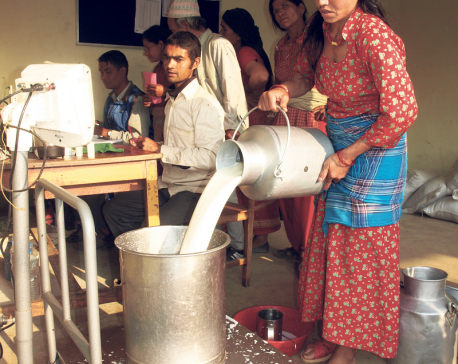
OR
Opinion
Unlocking Growth of Small and Medium-size Enterprises
Published On: December 17, 2023 09:00 AM NPT By: Hari Prasad Shrestha

SMEs are the backbone of the economy to accelerate production and provide a wide range of jobs
Commercial banks are more interested in financing big business houses, and they are least interested in financing SMEs. Similarly, due to the rising problem of irregularities in the microfinance and the cooperatives sector, small and medium enterprises are facing problems in their financing.
Developing countries tend to have a larger share of small and medium-sized enterprises (SMEs) or by adding micro enterprises, it is pronounced to be micro, small and medium sized enterprises (MSMEs) . SMEs are important for economic and social reasons, as it contributes to a large number of job creation, employment and GDP growth in a number of countries. SMEs, generally outnumber large companies by a wide margin and also employ many more people.
SMEs are the driving force behind economic growth and it is classified based on the industry, assets, number of employees, and sales. In countries that belong to the Organization for Economic Co-operation and Development (OECD), such as the United States and EU nations, in the US, SMEs are firms with fewer than 500 employees, while EU countries limit the number to 250 employees. In China, making up about 97% of all enterprises in the country, SMEs in the retail sector need to have fewer than a hundred employees and a revenue of less than RMB 10 million to be classified as a small company. When the retail company exceeds a hundred employees and starts earning more than RMB 10 million per year, it is considered a medium-sized enterprise.
Similarly in India, micro enterprises with 1 crore investment with annual turnover of 5 crore should pay 8% tax, small enterprises with 10 crore investment with annual turnover of 50 crore should pay 10% tax and medium enterprises with 20 crore investment with annual turnover of 100 crore should pay tax of 12 %. MSMEs created 120 million jobs across all industries in India. Micro and small enterprises play an important role in the economy; it accounts for 33% of India’s GDP.
In Bangladesh, a significant dimension that has emerged in recent decades is the expansion of small and medium enterprises. The growth of SMEs, especially in the last one decade, has been quite astonishing. From the mid-1980s, its number has increased four to five times and the contribution to the country's GDP has also reached as high as 25 percent, while their number increased to 7.9 million. As many as 24 million people are estimated to be engaged in SMEs, which is around 30 percent of the total employed workforce. Moreover, SMEs are gradually becoming one of the key sources of employment generation for women in Bangladesh.
As far as Nepal is concerned, the United Nations Economic and Social Commission for Asia and the Pacific (UNESCAP) report estimates that Nepal's MSMEs employ more than 2.7 million people. In Nepal, it’s estimated there are more than 923,000 registered businesses and approximately 90 percent of those are MSMEs, accounting for 45 percent of all jobs. For MSMEs in Nepal, the projected financing gap is estimated at $3.6 billion, with only around $731 million currently available for them. The Department of Industry has been registering eight types of industries including services, agriculture and forest, manufacturing, tourism, construction, energy, minerals and information technology. There are a majority of unregistered informal micro and small enterprises concentrated in the service sector.
SMEs in Nepal are facing many problems for its expansion and growth. The major barriers to micro and small enterprises are the limited availability of markets as illegally imported commodities are creating challenges for them. Policy bias in favor of a handful of big businesses and against small and medium enterprises has created a void in which growing enterprises face difficulties. The monopoly in large enterprises and in dealership businesses whether it is related to vehicle or other consumable items, earning the highest percentage of profits have squeezed the grounds for expansion of SMEs. Such a monopoly must be ended and the general public and SMEs must be allowed to do businesses and dealerships openly.
There are also other issues such as the problem of scaling up of enterprises from small to medium and up to large as most SMEs discontinue to function due to lack of government’s collective policy support. Commercial banks are more interested in financing big business houses, and they are least interested in financing SMEs. Similarly, due to the rising problem of irregularities in the microfinance and the cooperatives sector, small and medium enterprises are facing problems in their financing.
Based on global practice and experiences, SMEs are the backbone of the economy to accelerate production and provide a wide range of jobs. Rapid growth of SMEs could support the decline in the outflow of Nepali nationals opting for foreign employment. Therefore, the government must acknowledge the growing importance of SMEs by forming a new separate act based on international practices. An independent regulator or a separate department is needed for smooth administration of SMEs from a single door. Moreover, amendments in some existing laws, such as foreign direct investment, tax and labor laws, bank and financial institutions laws and safeguarding of domestic industries should be done on priority basis. Provinces and local level governments should be also given proper roles to support SMEs as well.
The contribution of SMEs to the GDP of Nepal is not at a considerably satisfactory level. There are huge funding gaps for their growth. The government, through budgetary support to small and medium enterprises should aim for a long-term target of contribution to the GDP up to 50%. Moreover, SMEs whose business revolves around modern technologies should be also exempted from enterprise income tax for a reasonable period. SMEs that provide work to unemployed workers, may be eligible for tax exemptions for specified periods of time. More importantly, the income tax rate for SMEs should be also lowered compared to large enterprises.
SMES should be given a reduction in electricity bills and the state-owned banks as well as the private banks should be encouraged to create specialized departments to serve solely SMEs by offering collateral free loans at lower interest rates. In addition, a separate bond market could be supportive to support the SMEs to solve the problem of credit crunch.
SMEs need internal funding in initial stages and more external funding to grow at an advanced stage. SMEs could spur a country’s growth by integrating proven practices and technologies faster and safer than testing new ones while markets can grow faster by adopting tested technologies. The government and the private sector should work together for the development of SMEs. Only the policies brought in collaboration between the government and the private sector will help maintain economic stability and rapid development of SMEs.
You May Like This

Udayapur cement says irregular power supply hitting production
UDAYAPUR, JUNE 20: Government-run Udayapur Cement Industries Ltd (UCIL), producer of Gaida cement, is facing losses due to irregular supply of... Read More...

Tea production in Ilam likely to fall by a fifth
ILAM, Oct 29: Tea production in Ilam is likely to drop by about a fifth this year due to incessant rainfall... Read More...

Kavre district declared self-sufficient in milk production
BANEPA, July 29: Despite being a nation with agriculture at the core of its economy, much of the country reels... Read More...











Just In
- Challenges Confronting the New Coalition
- NRB introduces cautiously flexible measures to address ongoing slowdown in various economic sectors
- Forced Covid-19 cremations: is it too late for redemption?
- NRB to provide collateral-free loans to foreign employment seekers
- NEB to publish Grade 12 results next week
- Body handover begins; Relatives remain dissatisfied with insurance, compensation amount
- NC defers its plan to join Koshi govt
- NRB to review microfinance loan interest rate








Leave A Comment